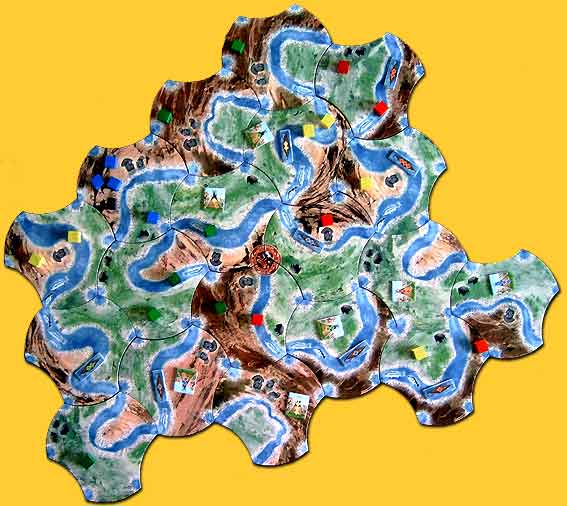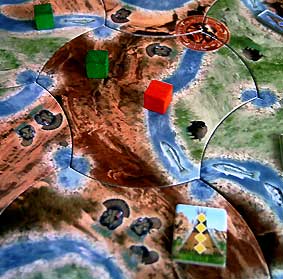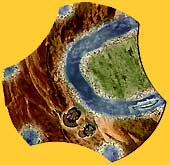Bison
page 2
 |
 |
|
|
|
|
|
|
|
|
|
|
|
|
|
|
|
|
|
|
|
|
|
|
|
|
|
|
|
|
|
|
|
|
|
|
|
|
|
|
|
|
|
|
|
|
|
|
|
In the end every player in ‘Bison’ is quite busy with cube management: mark the action with a neutral cube, adjust the inventory with cubes, and put Indians, cubes, on the tiles, or move or replace these cubes.
What can be quite confusing at start is that players have their canoes, wigwams and Indians in their personal supply, all paid for when acquiring it from the general market, but still have to pay for the action when it involves more than one Indian. This is something one has to get accustomed to when playing the game for the first time.
The ‘loose’ Indians have to be exchanged for a wigwam or a canoe as soon as possible; this way they return to the personal supply and will not have to be hired at a high price at the general market.
|
| x |
|
|
|
|
|
|
|
|
|
|
|
|
|
|
|
|
|
|
|
|
|
|
|
|
|
|
|
|
|
|
|
|
|
|
|
|
|
|
|
|
|
|
|
|
|
|
|
|
|
|
 |
|
The illustrations by Franz Vohwinkel strike as somewhat forced; the more or less photo realistic landscapes seem to have been stretched by the computer at places. A second, game technical reason is that different types of landscape are allowed to be adjacent, as a result of which two tiles can have a rather abrupt transition.
The end score feels a bit artificial too: during game play players have been trying to collect as much animals as they could get, but at game’s end the inventory of all animals first is put back to zero, and only the animals from a last score get added. Players should note that because of this rule it is of no use to be very prudent in the use of the animals during the last round.
|
| x |
|
|
|
|
|
|
|
|
|
|
|
|
|
|
|
|
|
|
|
|
|
|
|
|
|
|
|
|
|
|
|
|
|
|
|
|
|
|
|
|
|
|
|
|
|
|
|
|
|
|
|
When a player has placed his 4- wigwam or canoe in an area, the heat is out for other players and they can shift their attention to an other area to try to get a majority there, possibly with their own 4- wigwam or canoe.
The presence of many Indians in just one area is not a good idea; it is better to have an overall presence in many areas; keeping in mind that the third or fourth position may score more than a second place! This is a nice touch to the game; it makes the considerations to be made even harder, but also spices up the game.
|
| x |
|
|
|
|
|
|
|
|
|
|
|
|
|
|
|
|
|
|
|
|
|
|
|
|
|
|
|
|
|
|
|
|
|
|
|
|
|
|
|
|
|
|
|
|
|
|
|
|
|
|
|
‘Never a dull moment’, the boys at the R&D department at Phalanx probably must have thought. In ‘Mesopotamia’ we already were treated on an inventive jagged tile, in ‘Bison’ we may welcome the variant on the hexagon. It keeps us curious about any next game by Phalanx, that’s for sure!
‘Bison; is an attractive game with a grow factor: it does not grab you instantly in a first play, but after several plays one gets intrigued by the possibilities, and more: the limitations! In this regard it is the same old story of wanting to do a lot, and only being able to do little.
Striking detail: the near finished game at first showed eagles to be hunted for, but the American publisher thought the hunting for their national symbol was not done. So instead of eagles, now turkeys come flying from the mountains!
© 2006 Richard van Vugt
|
  |
|
|
|
|
|
|
|
|
|
|
|
|
|
|
|
|
|
|
|
|
|
|
|
|
|
|
|
|
|
|
|
|
|
|
| x |
|
|
|
|
|
|
|
|
|
|
|
|
|
|
|
|
|
|
|
|
|
|
|
|
|
|
|
|
|
|
|
|
|
|
|
|
|
|
|
|
|
|
|
|
|
|
|
|
|
|
Bison, Wolfgang Kramer & Michael Kiesling, Phalanx Games, 2006 - 2 to 4 players, 10 years and up, 90 minutes
|
  |
|
|
|
|
|
|
|
|
|
|
|
|
|
|
|
|
|
|
|
|
|
|
|
|
|
|
|
|
|
|
|
|
|
|
|
|
|
|
|
|
|
|
|
|
|
|
  |
|
|
|
|
|
|
|
|
|
|
|
|
|
|
|
|
|
|
|
|
|
|
|
|
|
|
|
|
|
|
|
|
|
|
|
|
|
|
|
|
|
|
|
|
|
|
  |
|
|
|
|
|
|
|
|
|
|
|
|
|
|
|
|
|
|
|
|
|
|
|
|
|
|
|
|
|
|
|
|
|
|
|
|
|
|
|
|
|
|
|
|
|
|
  |
|
|
|
|
|
|
|
|
|
|
|
|
|
|
|
|
|
|
|
|
|
|
|
|
|
|
|
|
|
|
|
|
|
|
|
|
|
|
|
|
|
|
|
|
|
|
  |
|
|
|
|
|
|
|
|
|
|
|
|
|
|
|
|
|
|
|
|
|
|
|
|
|
|
|
|
|
|
|
|
|
|
|
|
|
|
|
|
|
|
|
|
|
|
  |
|
|
|
|
|
|
|
|
|
|
|
|
|
|
|
|
|
|
|
|
|
|
|
|
|
|
|
|
|
|
|
|
|
|
|
|
|
|
|
|
|
|
|
|
|
|
| x |
|
|
|
|
|
|
|
|
|
|
|
|
|
|
|
|
|
|
|
|
|
|
|
|
|
|
|
|
|
|
|
|
|
|
|
|
|
|
|
|
|
|
|
|
|
|
|
|
|
|
| x |
|
|
|
|
|
|
|
|
|
|
|
|
|
|
|
|
|
|
|
|
|
|
|
|
|
|
|
|
|
|
|
|
|
|
|
|
|
|
|
|
|
|
|
|
|
|
|
|
|
|
 |
|
|
|
|
|
|
|
|
|
|
|
|
|
|
|
|
|
|
|
|
|
|
|
|
|
|
|
|
|
|
|
|
|
|
|
|
|
|
|
|
|
|
|
|
|
|
 |
|
|
|
|
|
|
|
|
|
|
|
|
|
|
|
|
|
|
|
|
|
|
|
|
|
|
|
|
|
|
|
|
|
|
|
|
|
|
|
|
|
|
|
|
|
|
 |
|
|
|
|
|
|
|
|
|
|
|
|
|
|
|
|
|
|
|
|
|
|
|
|
|
|
|
|
|
|
|
|
|
|
|
|
|
|
|
|
|
|
|
|
|
|
| x |
|
|
|
|
|
|
|
|
|
|
|
|
|
|
|
|
|
|
|
|
|
|
|
|
|
|
|
|
|
|
|
|
|
|
|
|
|
|
|
|
|
|
|
|
|
|
|
|
|
|
 |
|
|
|
|
|
|
|
|
|
|
|
|
|
|
|
|
|
|
|
|
|
|
|
|
|
|
|
|
|
|
|
|
|
|
|
|
|
|
 |
|
|
|
|
|
|
|
|
|
|
|
|
|
|
|
|
|
|
|
|
|
|
|
|
|
|
|
|
|
|
|
|
|
|
|
|
|
|
|
|